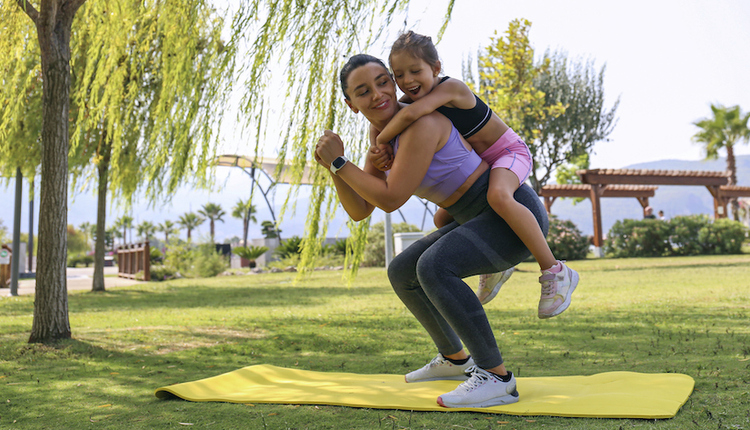Today there are so many different opinions on how one should exercise. Which type of training should I be doing is the big question? Do I perform slow reps, fast reps, do I use a bench or a physio ball, do I do one body part at a time? The answer is everyone should be training in a manner that relates to their individual goals. There is no set routine that equally benefits everyone who does it. Performing a typical gym program of random exercises 3 sets of 10 with 1 minute rests has limited benefits. Training primarily with machines without integrating free weights into a program is inefficient because you are moving resistance along a fixed axis and not free in space, as the body normally functions.
Functional training is defined as movements or exercises that improve a person's ability to complete their activities of daily living with greater efficiency and effectiveness. A functional program targets specific movements then mimics those movements during exercise. A good program focuses on weak areas and sets specific goals. An example of a functional exercise is having a tennis player lunge to a chop or a young mother squat to a twist.
It is important that the body is exercised in a functional manner in order to build appropriate muscle, joint strength, balance and flexibility in all planes of motion. It is crucial to include multi joint and multi-planar exercises, this recruits the body's stabilizers to synergistically facilitate movement. Doing this ensures that the nervous system is working properly and using all parts of the body in the appropriate manner with the correct muscles firing at the right time.
Core stability, flexibility and balance are key factors when designing a functional exercise routine. It is important to maintain posture while being able to move all joints in a full range of motion. Training with free weights and challenging the surrounding environment promotes balance and stability, which is necessary if you expect to see benefits outside of the gym. Keep in mind it is more important to be able to control your own body weight and concentrate on form, balance and core endurance than to move heavy weights.
A functional core routine consists of dynamic movements, challenges the center of gravity and isometric exercises. To completely train the core, you must also include dynamic stabilization, isometric and proprioceptive movements not just for the mid section but the entire trunk. Medicine balls, balance boards, foam rollers and physio balls are great tools for core training and should be integrated into every program. It is a fact that training on the physio ball (challenged environment) is superior to traditional floor exercises (1). As a person ages, balance and stability become compromised. If balance and stability are not addressed, they will consistently degrade. A weak core contributes to poor stability and inhibits proper limb movements causing muscle imbalances in the kinetic chain. This is why falls are common in the geriatric population. Many back and hip injuries are related to weak core muscles. There are many small muscles in the core that the general population knows little about or addresses during exercise. MRI images show atrophy in these small muscles in most spinal injuries (2-6). These little muscles need to be trained in order to maintain a healthy spine (2-6). Without stability, even the strongest person cannot effectively propel a force into the environment.
Flexibility is a very important facet of any exercise program, but is often over looked. In my opinion, lack of flexibility is the root of many problems. The body's movements are hampered when flexibility and posture are distorted. Active, dynamic, static and PNF stretching are key factors and should all be included in any training program. When a muscle is tight, it limits the muscle's ability to contract properly, causing inefficient movements and risk of injury. Without flexibility the body's movement becomes limited, and good results are difficult to achieve.
This article has explained the key components of a functional program and its benefits. Traditional weight lifting is a thing of the past and has been proven to produce limited results compared to a functional program. The fact is the only way to enhance movement is to mimic the movement in the gym until it becomes autonomous in everyday life. Before initiating any exercise program, one should always consult a physician, as well as a qualified fitness professional. This insures that they are addressing their specific needs and goals.
FAQ:
Q) Should I do slow repetitions or fast?
A) You base the speed of the repetition on the speed of the required activity.
The body needs to be trained at the same or a higher velocity during exercise to benefit a particular activity. A sprinter doesn't jog to increase their speed.
In my opinion slow training is good for form training, rehabilitation and hypertrophy.
Q) Can functional training benefit anyone?
A) Yes. Functional workouts are beneficial for any athletic level or age group. By training functionally your time in the gym is spent more efficiently. When you train in this fashion you will see drastic improvement in overall health and performance not just appearance.
Q) Aren't aerobic classes and the treadmill enough?
A) NO! A weight training program that includes balance, core stability strength and cardiac conditioning builds lean muscle mass. When you build muscle you burn more calories at rest and during daily activities. Which would mean by adding resistance to your program you actually will burn more calories doing the same aerobic class or distance on the treadmill.
Q) Should I stretch before or after exercise or an event?
A) Evidence demonstrates that static stretching before an activity is not beneficial to prevent injury. If you want to avoid injury you need to be flexible by stretching regularly and not just before activity. Active and dynamic stretches with a short warm up mimicking activity before, P.N.F and static stretching at the end help remove waste from the muscles.
Q) Why have none of my doctors told me to stretch and exercise to alleviate pain?
A) Unfortunately we live in a society of doctors that prescribe meds for everything imaginable. Everyone wants immediate gratification (pill) not a long term solution(exercise). The fact is most people would ignore the doctor's request to stretch and exercise then seek a new doctor for a simpler solution. Most minor health problems can be eliminated by moderate exercising but people choose to take meds because they are lazy.
Q) I injured my knee and my doctor told me to rest it for a while. Do I?
A) This is the worst thing you can do. Pampering an injury for extended periods causes muscle atrophy and decreased blood flow. All injuries should be functionally rehabilitated under careful supervision.
Q) Should I cut carbs out of my diet?
A) NO! Cut high glycemic carbs out only. Carbohydrates are essential for cellular function. Eating carbs that do not spike insulin levels is healthy and effective for weight loss.
Q) My doctor told me to walk to get some exercise for my aches. Is walking enough?
A) NO WAY. If walking were enough basically everyone would be healthy since we all walk. If you have pain chances are there is a biomechanical issue. My first suggestion would be to stretch. More walking will only aggravate the issue you need to correct the imbalance first not just walk more.
Meet the Author:
Charles DeFrancesco is the Continuing Education Specialist for National Federation of Professional Trainers (NFPT) and is an accomplished author and presenter in various disciplines; core training, sports and strength conditioning, functional training and flexibility. Charles is a Functional Exercise Specialist, certified by NASM and NFPT, with over 5,000 hours of clinical experience. As the chief developer and owner of educational programming at Westchester Sports and Wellness and consultant for Pure Fitness, LLC and Fit and Functional, LLC, Charles enjoys independent consulting and development with commercial gyms, corporate parks and fitness studios.
References:
1 Cosio-Lima LM, Reynolds KL, Winter C, Paolone V, Jones MT.
Effects of physioball and conventional floor exercises on early phase adaptations in back and abdominal core stability and balance in women.
J Strength Cond. Res.2003 Nov;17(4):721-5
2 Hides, J. A., Richardson, C. A., and Jull, G. A. Magnetic resonance imaging and ultrasonography of the lumbar multifidus muscle. Comparison of two different modalities. Spine 20:54-8; 1995
3 Hides, J. A., Stokes, M. J., Saide, M., Jull, G. A., and Cooper, D. H. Evidence of lumbar multifidus muscle wasting ipsilateral to symptoms in patients with acute/subacute low back pain. Spine 19:165-72; 1994
4 Kiyoshi Yoshihara, MD; Yasumasa Shirai, MD; Yoshihito Nakayama, MD; Shinji Uesaka, MD. Histochemical Changes in the Multifidus Muscle in Patients With Lumbar Intervertebral Disc Herniation. Spine 2001;26:622-626
5 Julie A. Hides, PhD; Carolyn A. Richardson, PhD; Gwendolen A. Jull, MPhty Multifidus Muscle Recovery Is Not Automatic After Resolution of Acute, First-Episode Low Back Pain. Spine 1996;21:2763-2769
6 Etty Griffin LY. Neuromuscular training and injury prevention in sports.
Clin Orthop.2003 Apr;(409):53-60
Related to:
Dec. 1 2011













